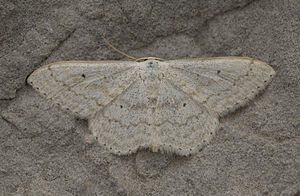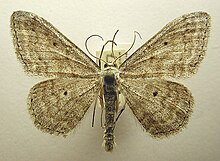White-gray small clamp
| White-gray small clamp | ||||||||||||
|---|---|---|---|---|---|---|---|---|---|---|---|---|

White-gray small spanner ( Scopula incanata ) |
||||||||||||
| Systematics | ||||||||||||
|
||||||||||||
| Scientific name | ||||||||||||
| Scopula incanata | ||||||||||||
| ( Linnaeus , 1758) |
The white-gray small spanner ( Scopula incanata ), also known as the silver- gray small spanner , scree slope or gray spanner , is a butterfly ( moth ) from the spanner family (Geometridae).
features
The moths reach a wingspan of 24 to 30 millimeters (or 25 to 28 millimeters) the second generation is on average significantly smaller with a wingspan of 20 to 25 millimeters. The apex of the forewing is slightly pointed. The basic color of the wings is light gray with a darker gray over-dusting. The transverse lines are colored dark gray to brownish gray. While the inner transverse line is rather indistinct, is often only marked by points on the wing veins or is absent, the middle shadow and outer transverse line are usually stronger. The middle shadow is usually diffuse, the outer transverse line toothed, with the serration directed towards the outer edge. The outer transverse line is not curved at the costal edge. In contrast, the inner transverse line, if present, is clearly curved towards the wing base. The border area is usually colored gray and has a whitish wavy line. There are discal spots on the fore and hind wings. The hem is also studded with dots. The fringes are usually kept in the basic color, e.g. Partly also dotted at the base (offset to the hem points). This often makes the fringes look slightly piebald. The strong drawing and dark gray over-dusting is induced by cold and humid conditions during pupal time. Lighter specimens with little drawing are more likely to arise in warm and dry conditions during the pupal phase.
The egg is slightly conical, but a little wider at the top. It is initially yellow when it is deposited and later, shortly before the egg caterpillars hatch, red spots appear on the surface. The surface has 18 strong longitudinal ribs and finer transverse ribs.
The slender caterpillar is whitish gray to yellowish gray with an indistinct, darker topline, which is interrupted by the segment incisions.
The red-brown pupa has wing sheaths overflowing with green. The rounded end of the small Kremaster has two diverging, outwardly curved, pointed bristles. On each side there are two fine, hook-like, shorter bristles.
Similar species
The white-gray small spanner is very similar to the marginal spot small spanner ( Scopula marginepunctata ). In this type, however, the outer transverse line at the Kostalrand bends strongly inward. The forewing apex is more rounded, the forewings are more sand-colored with significantly less gray. The butterflies are on average a little smaller than the butterflies of the white-gray small spanner.
Geographical distribution and habitat
The distribution area extends from the Iberian Peninsula in the west to the Urals in eastern Europe. However, the occurrences are very local and scattered, especially in Western and Central Europe. In the north, the area extends roughly into central Fennoscandia and the northern Baltic states . In southern Europe there are isolated occurrences in central Italy and southern Greece ( Peloponnese ), and probably also in Sicily . Otherwise it is missing on all Mediterranean islands, as well as in the north on the British Isles . In Central Europe the species occurs almost exclusively in the hill country and in the mountains, in Northern and Eastern Europe in the lowlands. In the east, the distribution area extends to Asia Minor , the Caucasus , northern Iran , northern Kazakhstan , Siberia , the Altai Mountains to Yakutia and eastern Mongolia .
The species prefers dry, warm, sunny habitats mostly in the hilly or mountainous areas, scree slopes, quarries, gravel pits, abandoned vineyards, stony meadow slopes with sparse vegetation (e.g. limestone grasslands), often overgrown with thyme ( thymus ). The species has even been observed in peripheral locations with gardens, hedges, orchards and ruderal areas. In Denmark at sea level it lives on gray sand dunes. It rises up to 1500 meters in the Northern Alps and up to 2000 meters in the Southern Alps. In southern Europe it usually only occurs from 1000 to 2300 meters above sea level. In Iran it rises up to 2,700 meters.
Way of life
The white-and-gray small spanner usually forms two generations a year, the moths of which fly from the beginning of May to mid-September, usually with a gap in July. In climatically favorable regions in Central Europe, in the Southern Alps and in the Mediterranean area, three generations are usually formed, the moths of which fly from late March to November. In the north of the distribution area and in the mountains only one generation is trained; the moths fly there from late June to early August. The moths rest on stones and branches during the day, but they can also be observed when visiting flowers. They are crepuscular and nocturnal and come to artificial light sources. The caterpillars live polyphagous on various herbaceous plants . In the literature the following are mentioned: bird knotweed ( Polygonum aviculare ), rowanberry ( Sorbus aucuparia ), sand thyme ( Thymus serpyllum ), oregano ( Origanum vulgare ), noble germander ( Teucrium chamaedrys ), bluebells ( Campanula ), pechnelks ( Lychnis ), Carnations ( Dianthus ), common horseshoe clover ( Hippocrepis comosa ), broom broom ( Cytisus scoparius ). In Northern Europe the caterpillars seem to prefer thyme ( Thymus ) and species of the genus bird knotweed ( Polygonum ). The breeding was also successful with common clematis ( Clematis vitalba ), Mary's bellflower ( Campanula medium ), honeysuckle ( Lonicera ), purgatory buckthorn ( Rhamnus cathartica ) and dandelion ( Taraxacum ).
The 2nd (or 3rd generation) caterpillars overwinter and pupate in the spring of the following year.
Systematics and taxonomy
The taxon was first scientifically described by Carl von Linné in 1758 as Phalaena Geometra incanata . There are numerous synonyms. In the sub-genus of the genus Scopula (with three sub-genera) incanata Linné is placed to the sub-genus Calothysanis . Up to four subspecies are currently known:
- Scoula incanata incanata , in most of the distribution area
- Scopula incanata ibericata Reisser, 1935, on the western Iberian Peninsula , on average larger, with a lighter base color and a lighter border
- ? Scopula incanata albida Silbernagel, 1944, Macedonia , very light basic color
- Scopula incanata remmi Viidalepp, 1979, Mongolia and Yakutia
Danger
The endangerment situation of the white-gray small spanner is very different in the individual German federal states and ranges from “not endangered” (e.g. Baden-Württemberg) to extinct (category 0) (e.g. Mecklenburg-Western Pomerania and Saarland). The species is endangered (category 2) in North Rhine-Westphalia and endangered (category 3) in Rhineland-Palatinate and Saxony.
swell
Individual evidence
- ↑ a b Red List at Science4you
- ↑ a b c Hausmann (2004: pp. 307-310)
- ↑ a b Skou (1986: p. 42/3)
- ^ Bergmann (1955: pp. 93, 96–98)
- ↑ a b c d Forster & Wohlfahrt (1973: p. 48/9)
- ↑ a b c Ebert (2001: pp. 133–135)
- ^ Carl von Linné: Systema naturæ per regna tria naturæ, secundum classes, ordines, genera, species, cum characteribus, differentiis, synonymis, locis. 10th edition, Stockholm 1758 Online at SUB Göttingen (description of the species p. 528)
- ↑ Fauna Europaea
- ↑ Jaan Viidalepp: On the fauna of Lepidoptera of Tuva ASSR. IV. Geometridae. Acta et Commentationes Universitatis Tartuensis, 12 (483): 79-133. (In Russian) (Description p. 84/5). Image of the subspecies Scopula incanata remmi
literature
- Arno Bergmann: The large butterflies of Central Germany. Volume 5/1: Spanner. Distribution, forms and communities. Urania-Verlag, Jena 1955, DNB 450378403 .
- Günter Ebert (Ed.): The butterflies of Baden-Württemberg . Volume 8, Nachtfalter VI (Spanner (Geometridae) 1st part), Ulmer Verlag Stuttgart 2001. ISBN 3-800-13497-7
- Walter Forster , Theodor A. Wohlfahrt : The butterflies of Central Europe. Volume 5: Spanner. (Geometridae). Franckh'sche Verlagshandlung, Stuttgart 1981, ISBN 3-440-04951-5 .
- Axel Hausmann: The Geometrid moths of Europe, 2nd Sterrhinae. Apollo Books, Stenstrup 2004, ISBN 8-788-75737-4
- Peder Skou: The geometroid moths of North Europe (Lepidoptera, Drepanidae and Geometridae). 348 S., Leiden, Brill, 1986 online at GoogleBooks
annotation
- ↑ Bergmann (1955) created the trivial name Grauweißer Schöllhalden-Kleinspanner, which was not considered in the following literature.
